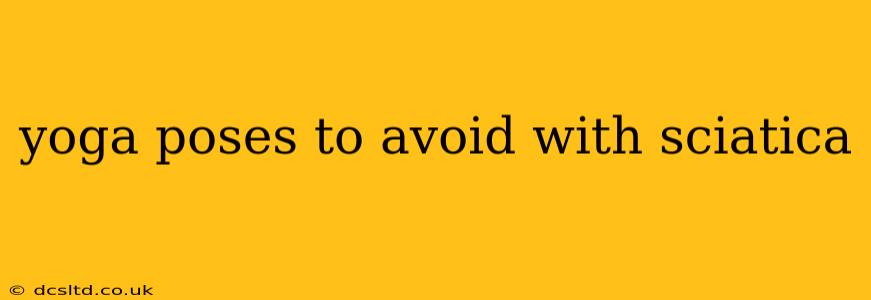Sciatica, that sharp, shooting pain radiating down the leg from the lower back, can make even the simplest movements feel excruciating. For those who find solace and relief in yoga, navigating poses becomes crucial. While yoga can be incredibly beneficial for managing sciatica pain, certain poses can exacerbate the condition. This guide explores yoga poses to avoid with sciatica, along with safer alternatives, empowering you to practice mindfully and protect your well-being.
What is Sciatica?
Before delving into specific poses, it's important to understand sciatica. Sciatica isn't a condition in itself but a symptom of an underlying issue, often involving compression or irritation of the sciatic nerve. This nerve runs from the lower back down through the buttocks and hips, branching into the legs and feet. Common causes include herniated discs, spinal stenosis, piriformis syndrome, and spondylolisthesis. The pain can range from mild discomfort to debilitating agony, often accompanied by numbness, tingling, or weakness in the affected leg.
Yoga Poses to Absolutely Avoid with Sciatica
Certain yoga poses, due to their spinal flexion, twisting, or intense stretching, can put undue pressure on the sciatic nerve, worsening symptoms. These should be avoided until pain is significantly reduced and under medical supervision.
1. Deep Forward Bends (Paschimottanasana, etc.):
Deep forward bends, while generally beneficial, can compress the spine and potentially irritate the sciatic nerve. The intense flexion can aggravate existing nerve compression.
2. Intense Spinal Twists (Ardha Matsyendrasana, etc.):
Twists, especially deep ones, can put pressure on the already compromised nerve. While gentle twists may be beneficial later in recovery, avoid intense spinal twists during acute sciatica pain.
3. Low Lunge with a Deep Twist:
This pose combines the negative aspects of both forward bends and twists, significantly increasing the risk of sciatica exacerbation.
4. Certain Hip Flexor Stretches:
While hip flexibility is important, some intense hip flexor stretches can compress the sciatic nerve if performed incorrectly or with pre-existing conditions. Always listen to your body and stop if you feel any pain.
5. Camel Pose (Ustrasana):
The deep backbend in Camel Pose can place significant pressure on the lower back and exacerbate sciatica pain.
Yoga Poses to Approach with Caution (Modify or Avoid if Pain Occurs)
Some poses may be tolerable for some individuals but could trigger pain for others. Start slowly, listen to your body, and modify the pose as needed. If you feel any pain, stop immediately.
- Triangle Pose (Trikonasana): This pose can be beneficial for stretching the hamstrings and hips, but be mindful of any pulling sensation in the lower back.
- Downward-facing Dog (Adho Mukha Svanasana): While generally beneficial, a tight hamstring can pull on the sciatic nerve in this pose.
- Cobra Pose (Bhujangasana): This backbend needs to be done carefully. Overarching the back can be problematic.
Safer Alternatives for Sciatica Pain Relief
Several yoga poses can provide relief and support healing without exacerbating sciatica:
1. Gentle Spinal Twists (Supine Spinal Twist):
Perform these twists lying down, allowing for gentle rotation without compressing the spine.
2. Supported Child's Pose (Balasana):
This resting pose gently stretches the hips and lower back while providing support.
3. Cat-Cow Pose (Marjaryasana to Bitilasana):
This gentle flow helps to improve spinal mobility and release tension in the back.
4. Knee-to-Chest Pose:
This gentle stretch helps relieve tension in the lower back.
5. Reclined Butterfly Pose:
This restorative pose opens the hips gently.
6. Happy Baby Pose:
This pose gently stretches the hips and lower back without excessive strain.
When to See a Doctor
If you experience sciatica, consult your doctor or a physical therapist. They can diagnose the underlying cause of your pain and recommend appropriate treatment. While yoga can be a valuable complementary therapy, it shouldn't replace medical advice.
FAQs
What type of yoga is best for sciatica?
Restorative yoga and Hatha yoga, focusing on gentle stretches and mindful movement, are often recommended.
Can yoga permanently cure sciatica?
Yoga can’t cure sciatica, but it can help manage pain, improve flexibility, and strengthen supporting muscles.
How long should I wait before doing yoga after a sciatica attack?
Wait until the acute pain subsides significantly before attempting any yoga poses. Consult your doctor or physical therapist for guidance.
Can I do yoga every day if I have sciatica?
Not necessarily. Listen to your body; rest when needed and modify poses to avoid pain.
By understanding which yoga poses to avoid with sciatica and embracing gentler alternatives, you can enjoy the many benefits of yoga while protecting your spine and promoting healing. Remember to always consult with a healthcare professional before starting any new exercise program, especially if you have a pre-existing condition.
